Inside Yale’s Alexandria
Request one item per minute every day for a decade and you still wouldn’t exhaust this secretive archive.
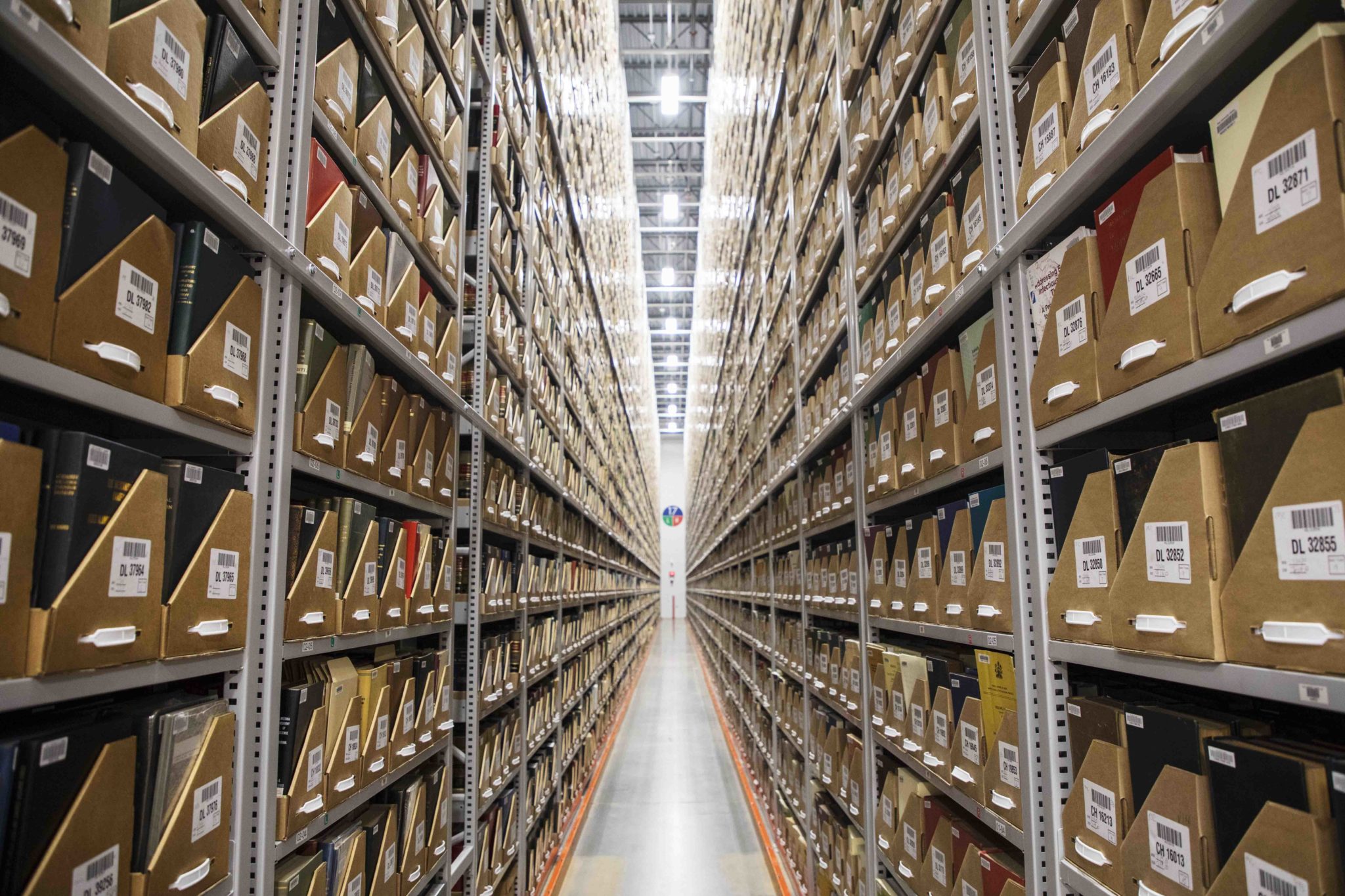
Take a drive all the way up Prospect Street, then hang a left where the road ends, then a right where it ends again. Keep going. Then you’ll see, past the Bible Gospel Center and its playground, across from the Engineering and Science University Magnet School and its brainiacs, what might be the most nondescript building not located in the former Soviet Union.
Much bigger than a breadbox and about twice the size of an American football field, this concrete cuboid is Yale’s Library Shelving Facility. You may know it better by its acronym, LSF, which on library catalogs — as the Quicksearch and Orbis fiends among us know — indicates that an item will need to be transported before you can pick it up and devour its insights. (Figuratively speaking, of course. Literal devouring of insights would violate library policy.)
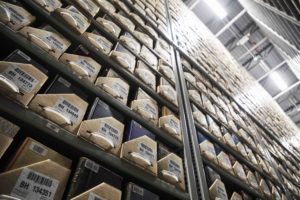 Inside are what the starry-eyed might call all of Yale’s riches. Numbering more than 7.5 million items, the LSF holdings include nearly all of the University’s archival materials not currently in use by patrons, as well as much of its circulating material and thousands and thousands of objects from the Yale University Art Gallery. Picture an Ikea warehouse, except much bigger and climate-controlled, and, instead of budget Swedish furniture, there are irreplaceable historical documents and artifacts and books.
Inside are what the starry-eyed might call all of Yale’s riches. Numbering more than 7.5 million items, the LSF holdings include nearly all of the University’s archival materials not currently in use by patrons, as well as much of its circulating material and thousands and thousands of objects from the Yale University Art Gallery. Picture an Ikea warehouse, except much bigger and climate-controlled, and, instead of budget Swedish furniture, there are irreplaceable historical documents and artifacts and books.
If you, like me, have trouble imagining just how many things add up to 7.5 million things, never fear. Using the quantitative reasoning skills I honed in my two required Quantitative Reasoning courses, I’ve done a bit of back-of-the-reporter’s-notebook math and can tell you that, supposing that you wanted, for kicks, to request every single item housed at LSF, and supposing also that you could do so at a brisk but constant rate of one request per minute, it would take you more than 14 years to work through the entire catalog. And that’s with no breaks, and to say nothing of how long it would take you to read all the material. What was it they said about the Library of Alexandria? That it was big? Maybe, but this place is big-big.
Usually LSF is closed to all but its stalwart attendants, who, despite the figurative and literal enormity of their task, somehow number just 13. Luck often visits upon the undeserving, though, so I recently got the chance to join a group of Very Important Persons during a rare tour.
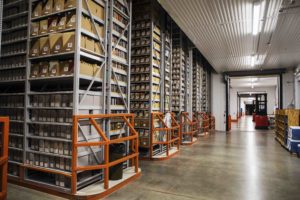 The facility is divided into a processing area and a set of storage modules; we began in a meeting room just inside the former. Michael DiMassa, longtime director of Library Collection Services and one of the Gilded 13, gave us a brief history lesson.
The facility is divided into a processing area and a set of storage modules; we began in a meeting room just inside the former. Michael DiMassa, longtime director of Library Collection Services and one of the Gilded 13, gave us a brief history lesson.
LSF celebrated its 20th birthday this Nov. 30. The University opened it in 1998 to address growing problems arising from overcrowding in on-campus libraries and has expanded it twice since then: once, in 2002, when five shelving modules were added to the initial module, and again, in 2009, when another three modules were added, as well as a new processing section for special collections materials. Some of the first materials to enter the facility were a set of thousands of boxes of Manuscripts and Archives materials that, to that point, had been stored in the tunnels that apparently connect Sterling Memorial Library and the Beinecke Rare Book and Manuscript Library. (The existence of these tunnels was a shock to me, though not to the VIPs, who work in the libraries and nodded along with DiMassa as if he had just been describing the weather.)
Past events accounted for, the LSF staff then took us deeper into the processing center to show us some of the present-day workings of the facility. We started at the southern end, where they pointed out the loading dock where the semitrucks that twice a day deliver materials to campus make their pick-ups and drop-offs. Moving north, we saw a cleaning station, where staff use car wash-like handheld vacuums to sanitize books coming in; a scanning station, where staff respond to an average of 30 or so digital scan requests per day; and then an assembling station, where staff group books into cartons before they enter the storage module.
At the facility, books are grouped not according to author or title or subject but, instead, according to size. Staff members consult a laminated diagram with 14 multicolored rectangles that correspond to common (and uncommon) book sizes and group them accordingly. This minimizes wasted shelf space and ensures that as LSF continues to ingest hundreds of thousands of new items each year, the facility can keep up with the vociferous appetite of the library system. (Eventually, of course, the facility will need to again expand, but these plans remain to be planned.)
The final step before items enter the storage module involves staff members double-checking that they match the carton they’re in. They accomplish this by way of scanning the special barcode that is affixed to each and every item stored at LSF; these are intended, assuming human civilization makes it that far, to last for the next 250 years.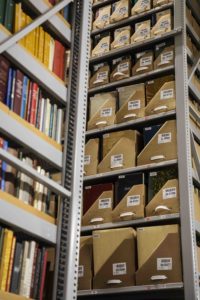
During the processing center portion of the tour, our guides and the VIPs talked a lot of shop about things like delivery schedules and organizational principles. At one point, one of our guides trashed what I now understand to be the considerably less efficient layout at Harvard’s storage facility. Much of their talk lay outside the purview of a general-interest magazine, but know this: These are people who know a lot, and care a lot, about what they do.
The necessity of their knowledge and care became obvious once we finally entered the storage module. In order to do so, we passed through a giant steel door that looks like something out of a bad bank heist movie, one of those slabs that pops a bit out of the wall upon the swipe of a VIP’s — and, presumably, only a VIP’s — ID card. Beyond the threshold was little fanfare; we had already arrived.
The advent and widespread adoption of the photo-capable high-resolution printing press spares me some of the hair-pulling task of trying to describe for you in words what I experienced in three dimensions and five senses, but here are a few facts that might not be obvious from the pictures: The shelves in the storage module are 30 feet high and three feet deep. They are arranged into 28 aisles. Every conceivable spot on these shelves is full — of what, I could not tell you, as the supremacy of the barcode here cancels out any possibility of casual browsing.
The entire module is kept at a cool 50 degrees and a relative humidity of 30 percent to minimize decay, especially of archival materials, and every light bulb in the building was recently replaced with a modern LED to further reduce damage. This is a place that is self-conscious of its simultaneous existence in space as well as time. The things here are meant to last in a way that’s more than a little humbling, even if the mission of a place like this — as the experiences at Alexandria and, more recently, at Brazil’s incinerated Museu Nacional show — is inevitably a fraught one.
We mortals on the tour putzed around on the warehouse floor for a bit, taking our pictures and listening to our guides explain how the staff uses harnesses and what are essentially cherry-pickers to move up and down aisles and shelves with agility. Whatever these people are being paid is not enough. They process up to a million items a year and — according to one of our guides, who knocked on a wooden desk as he said this — have never lost a thing.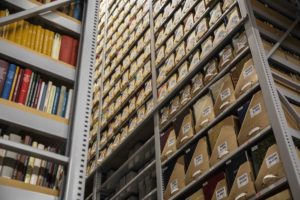
After about 20 minutes inside, we exited as discreetly as we entered. Passing through the processing center, we gave our guides our nicest thank-yous before emerging back into the parking lot. When Michael Lotstein, head of University Archives, turned and started speaking to me on our way to the car, I was, on the outside, still busy taking notes and, on the inside, still trying to incorporate what we had just seen into my mental model of the world.
“So, as you can see,” he said to me, “we’re not messing around.”







